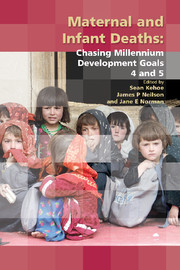Book contents
- Frontmatter
- Contents
- Participants
- Declaration of personal interests
- Preface
- The Millennium Development Goals
- SECTION 1 THE SIZE OF THE PROBLEM
- SECTION 2 CLINICAL PROBLEMS AND SOLUTIONS – MATERNAL
- SECTION 3 CLINICAL PROBLEMS AND SOLUTIONS – NEONATAL
- 12 Innovations for improving newborn survival in developing countries: do integrated strategies for maternal and newborn care matter?
- 13 Community interventions to reduce maternal and child mortality in low-income countries
- SECTION 4 TRAINING AND DEVELOPMENT
- SECTION 5 SPECIFIC CHALLENGES IN SPECIFIC COUNTRIES
- SECTION 6 CONSENSUS VIEWS
- Index
12 - Innovations for improving newborn survival in developing countries: do integrated strategies for maternal and newborn care matter?
from SECTION 3 - CLINICAL PROBLEMS AND SOLUTIONS – NEONATAL
Published online by Cambridge University Press: 05 February 2014
- Frontmatter
- Contents
- Participants
- Declaration of personal interests
- Preface
- The Millennium Development Goals
- SECTION 1 THE SIZE OF THE PROBLEM
- SECTION 2 CLINICAL PROBLEMS AND SOLUTIONS – MATERNAL
- SECTION 3 CLINICAL PROBLEMS AND SOLUTIONS – NEONATAL
- 12 Innovations for improving newborn survival in developing countries: do integrated strategies for maternal and newborn care matter?
- 13 Community interventions to reduce maternal and child mortality in low-income countries
- SECTION 4 TRAINING AND DEVELOPMENT
- SECTION 5 SPECIFIC CHALLENGES IN SPECIFIC COUNTRIES
- SECTION 6 CONSENSUS VIEWS
- Index
Summary
Introduction
Each year millions of women, newborns and children die from preventable diseases. Worldwide, more than 60 million women deliver at home every year without a skilled birth attendant and about 530000 women die from pregnancy-related complications, with about 68000 of these deaths resulting from unsafe abortion. About 4 million babies die within the first month of life and more than 3 million are stillborn. An estimated 9.2 million children die under the age of five, of which 40% of deaths occur during the neonatal period. Three-quarters of all neonatal deaths (3 million) occur within the first week of life and at least I million babies die on their first day of life. With only 5 years left to achieve the Millennium Development Goals (MDGs), many obstacles stand in the way. Inequality, poverty, illiteracy, civil unrest and the absence of good-quality care are the major obstacles in progressing towards better health of mothers and children, a key component of the MDGs. Achieving MDG4 to reduce the under-five mortality by two-thirds from the level in 1990 by the year 2015 is not only critically dependent on a substantial reduction in neonatal mortality but also on measures to address high burdens of maternal morbidity and mortality, which also have a major effect on newborn survival and child health.
Achieving MDG 5 of reducing the maternal mortality by three-quarters from the level in 1990 by 2015 requires concrete measures that may go way beyond the health sector.
- Type
- Chapter
- Information
- Maternal and Infant DeathsChasing Millennium Development Goals 4 and 5, pp. 187 - 204Publisher: Cambridge University PressPrint publication year: 2010



